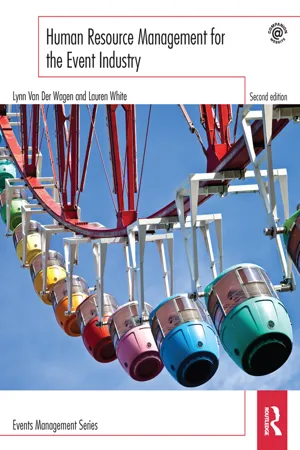Part I of this book establishes a context for human resource management in the event business. The different types of event include business events (conferences and exhibitions), sports, arts, entertainment and community events, street parades and festivals. These events may be commercial or not for profit. They may be fundraising events or simply big parties.
The functions of human resource management of recruitment, selection, induction, training and performance management are important parts of every event organizer’s job. In the case of large events, including mega events such as the Winter Olympic Games or FIFA World Cup, the size of the event would clearly warrant a specialist human resources team. For smaller events, these functions would be undertaken by the organizer, organizing committee or area managers.
In this environment, there is typically a diverse range of employment arrangements and very frequently there are volunteers involved. Most events are project based, occurring once only or annually. Chapter 1 will discuss the unique features of the event environment that differentiate it from other traditional business environments in which human resource management is practised. Chapter 2 will look at planning from a macro perspective, looking at the whole workforce that could include paid staff, volunteers and contractors (vendors/suppliers) who provide event services such as catering. The growth of the event team over time and the phases of organizational development will be covered in Chapter 3, shortly followed by a discussion in Chapter 4 of the issues associated with volunteer management. Chapter 5 deals with the employment of event service providers such as security, cleaning, waste management and technical support (lighting and sound). Having developed an awareness of the overall responsibility that the event organizer has for the health and safety of everyone working on site, the following chapter, Chapter 6, will discuss employment legislation in more detail. Finally, Chapter 7 will discuss the process of job analysis, leading to the development of job descriptions that form the basis for many other human resource functions (such as training) which are covered in Part II when the text moves on to operational planning. Overall, Part I is largely focused on the development of a strategic plan for human resource management of one or more events.
Learning objectives
After reading through this chapter you will be able to:
● Differentiate between events in terms of size, scope and type of event.
● Identify a range of factors that differentiate events from more traditional ongoing business enterprises.
● Discuss the management of events in terms of creative and organizational attributes of organizers.
● Describe contemporary, strategic approaches to human resource management.
● Differentiate between the different groups of people comprising the event workforce.
● Discuss the emergence of event management as a profession.
Introduction
International events such as the Olympic Games, FIFA World Cup, World Championship in Athletics, Americas Cup, Commonwealth Games and many other mega sporting events continue to grow in size and investment. Most importantly, this growth is matched by the almost exponential growth of the television audience that watches these world-class competitions. So much so, that the organizers of opening and closing ceremonies will freely admit that these ceremonies are no longer designed for the audience seated in the stadium, even if these spectators have paid thousands of pounds for their tickets. The ceremonies are designed with every camera shot in mind, and CAD designs are used to visualize the on-screen effects from the various camera positions well in advance, most particularly those from high vantage points above the stadium. Major sponsors want to know beforehand how their logos will appear in the footage of the ceremony – how they will be positioned and how long they will appear on screen. There are also all sorts of political pressures brought to bear on the design of the ceremonies programme, with the host country branding itself according to the images portrayed. There are athletes, performers, players, entertainers, ushers, security staff, police and a multitude of other staff, including volunteers, working behind the scenes and many others performing on the stage or field of play. Managing the interests of everyone involved, meeting deadlines on a multitude of projects that are codependent and immutable in their timelines are just a few of the challenges of this environment. The 2005 Live 8 Concerts were held in 10 cities, including London, Philadelphia, Paris, Berlin, Johannesburg, Rome and Moscow, and played to hundreds of thousands of people. A TV audience of several hundred million was watching the gigs. In this case, the event was not a sporting event but a social justice initiative to eliminate poverty in Africa. This example further illustrates the challenges of producing an event on such a large scale, with specific political and economic aims in mind. The workforce for mega events is similar in scale and composition, Beijing Olympic Games for example recruiting 70,000 volunteers for the Summer Games and 30,000 for the Paralympic Games (primarily students). However, it was reported that an additional 400,000 municipal volunteers provided other services outside of the venues and a record 1,125,799 people applied to be volunteers! The London Olympic Games recruited a similar number (70,000) but with a more diverse profile having received 240,000 volunteer applications. Rio’s diversity manifesto is as follows: ‘we demonstrate appreciation of human diversity. It strengthens friendship among all, welcomes and respects the participation of each individual in this collective movement, emphasizing the principle that we all belong to one single world’. The volunteers are however the friendly face of an event which is staged by a multidisciplinary team. There is the paid workforce of the organizing committee and the project management team to consider and they are the core staff carrying overall responsibility for a successful event.
The additional size and scope of the contractor workforce is generally underestimated, often as much as 50 per cent of the operational crew, including providers of goods and services, also known as vendors. Many services, such as catering and cleaning, are contracted out and there is sometimes debate about whose responsibility it is to develop the event-related knowledge and customer service skills required by contractor employees on the site. As Goldblatt points out,
You are being paid for creating memorable positive experiences, and you and your staff are the critical resource that makes the guest’s experience memorable. Issues such as your human resource organization, training, and employee retention are vital if you are to remain competitive.
(Goldblatt, 2005b: 108)
Events: a new context for human resource management
Events are not only challenging in their size, scope and timeline. Many events are smaller, locally based and involve only a l...


